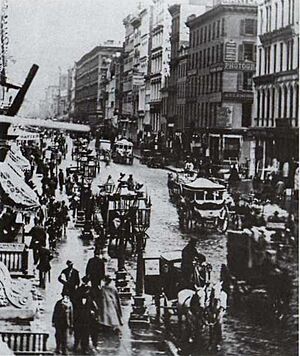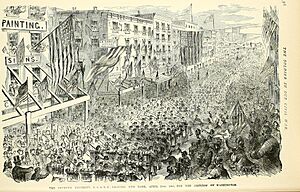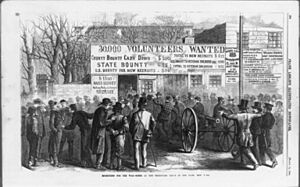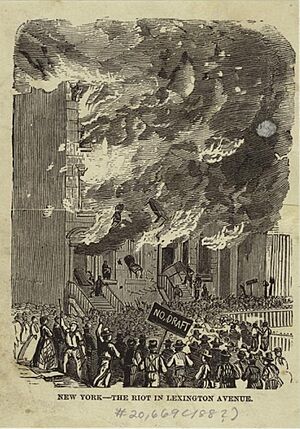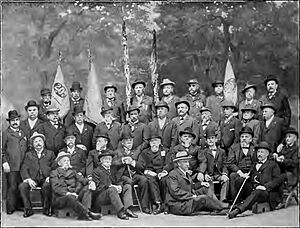New York City in the American Civil War facts for kids
New York City was a very busy place during the American Civil War (1861–1865). It was a major source of soldiers, supplies, equipment, and money for the Union Army. Important politicians and newspaper editors in New York helped shape what people thought about the war and the plans of U.S. President Abraham Lincoln. The port of New York was a main entry point for people coming to America, and it was also a place where the Army found many new recruits. Many Irish-Americans and German-Americans joined the war effort.
However, New York City also had strong business connections with the South. Its growing population of immigrants, and anger about the draft (being forced to join the army), led to mixed feelings. Some business people supported the Confederacy, while others supported the Union. The New York Draft Riot in 1863 was a very serious event. It happened because people were worried about losing jobs and were angry that rich people could pay to avoid the draft. This riot involved a lot of violence, especially by Irish immigrants against Black people in the city. But the nearby and larger City of Brooklyn was more supportive of the war.
Contents
New York City in the Early War Years
New York City had been the biggest and most important city in the United States for a long time. By 1860, it was home to many different kinds of people with various ideas and political views. When Southern states started to leave the Union after Lincoln was elected, most New Yorkers supported the war. But there were some exceptions.
The city and state had strong business ties to the South. By 1822, half of the city's exports were related to cotton. This cotton also supplied textile factories in upstate New York and New England. Mayor Fernando Wood served from 1860 to 1862. He was one of many New York Democrats who felt sympathy for the Confederacy. People who strongly supported the Union called them "Copperheads." In January 1861, Mayor Wood even suggested that New York City should secede and become a "Free City of Tri-Insula." This way, it could keep its profitable cotton trade with the Confederacy. Wood's Democratic group wanted to protect the city's income and jobs, which depended on Southern cotton.
Politically, Democrats mostly controlled the city. Many of them were part of a powerful political group called Tammany Hall. Led by William "Boss" Tweed, Democrats won many offices in New York City, and in the state legislature and as judges. They often did this through unfair methods. From 1860 to 1870, Tweed controlled most Democratic choices in the city. Republicans usually controlled Upstate New York. People who supported Lincoln formed the Union League to help the war effort and the president's plans.
Several U.S. Army forts, built before the war, held Union troops. They protected New York Harbor and the city from possible Confederate attacks, but no attacks happened. Fort Lafayette, Fort Schuyler, and others were used to hold hundreds of Confederate prisoners. The Army also built or expanded large military hospitals, like McDougall Hospital and De Camp General Hospital. These hospitals cared for the growing number of wounded and sick soldiers. One military invention from New York City was the "Wig-Wag Signaling" system. Major Albert J. Myer tested it in New York Harbor.
Riker's Island was used as a military training ground during the Civil War. Both white soldiers and United States Colored Troops (African American soldiers, allowed starting in 1863) trained there. New soldiers trained at "Camp Astor," named after the rich man John Jacob Astor III, who gave money for the army. One of the first groups to train at Camp Astor was the Anderson Zouaves. Their leader was Col. John Lafayette Riker, whose family used to own the island.
The New York Navy Yard, started in 1801 in Brooklyn, was a major place for building and fixing Union Navy ships. By the second year of the Civil War, the Yard had about 6,000 workers. Besides government factories, hundreds of small private businesses around New York also made military items. These included supplies, tools, and comfort items for soldiers.
Joining the Army
After the attack on Fort Sumter, President Lincoln asked for volunteers to join the Union army. Even though some people in New York objected, many New Yorkers quickly joined the army. Others helped raise money and support for the new troops. In just three months in early 1861, the city raised $150,000,000 for the war. By the end of May 1861, New York had sent 30,000 men to the volunteer army. This included the "New York Fire Zouaves" (11th New York Volunteer Infantry Regiment), led by Elmer Ellsworth, a friend of Lincoln. Troops marched down Broadway to cheers as they left for the war. Over the whole war, the city sent over 100,000 troops from around the state. New York City itself raised over 150,000 volunteers. Also, 30,000 to 50,000 sailors joined the Navy in New York City.
Besides the Fire Zouaves, other groups from New York City became well-known in the Union army. These included the 1st U.S. Sharpshooters (under Col. Hiram Berdan), the 9th New York Volunteer Infantry Regiment (Hawkins' Zouaves), and the 10th New York Volunteer Infantry Regiment ("National Guard Zouaves").
In 1862, George Opdyke became mayor of New York City, taking over from Fernando Wood. Opdyke strongly supported Lincoln. He worked hard to raise and equip more state troops. He also tried to prevent money problems on Wall Street as the Union's war success changed. Under his leadership, efforts to find new soldiers were renewed. They especially looked for the many immigrants in the city.
The Draft Riots
President Lincoln and many Republicans in the U.S. Congress wanted to finish the war. They were worried about the number of experienced soldiers whose time in the army was ending. So, they approved a law to draft (force) men into the army to add to the volunteers. "Draft Week" in New York City was planned for mid-July 1863. Because people were against the draft, Lincoln sent several groups of soldiers (some who had just fought at the Battle of Gettysburg) to control the city. Thousands of rioters, mostly Irish Catholics, took part.
The protests started to show anger at the draft. Richer men could pay someone else to take their place in the army. But the protests quickly turned into violence against Republicans and especially against Black Americans. The situation in the city was so bad that Maj. Gen. John E. Wool said on July 16, "Martial law should be announced, but I don't have enough soldiers to make it happen." After the first day, the military used cannons and bayonets to stop the crowd. But not before many buildings were robbed or destroyed. These included homes, the Tribune newspaper office, an orphanage for Black children, and P.T. Barnum's museum of interesting things.
Newspapers and the War

New York City had many popular newspapers and magazines. Their influence was felt all over the country. Horace Greeley, one of the people who started the Republican Party, made his New York Tribune America's most important newspaper from 1840 to 1870. Greeley used it to support the Whig and Republican parties. He also supported movements against slavery and other reforms. During the crisis of 1861, Greeley had a strong stance against the Confederacy. During the war, he became a voice for the Radical Republicans, who disagreed with Lincoln's more moderate approach. By 1864, he had less control over the newspaper. But he wrote an article saying he felt Lincoln had no chance of being reelected. Since his articles were printed across the country, his gloomy thoughts were widely read.
The New York Herald, owned by James Gordon Bennett Sr., often criticized Lincoln's government and its plans. However, Bennett and his newspaper strongly supported the Union. In 1864, Bennett supported George B. McClellan against Lincoln, but he did not officially support either candidate.
Besides the powerful newspapers, New York City was where several other important magazines were printed. These included Harper's Weekly, Frank Leslie's Illustrated News, and New York Illustrated News. The political cartoonist Thomas Nast became a famous person who commented on the war. His work helped create a feeling of loyalty and excitement for the Union. Reporters and artists like Alfred Waud gave the public firsthand stories from the Northern armies.
In early 1864, two journalists from the Brooklyn Eagle created a false story to trick people about money. This was known as the Civil War gold hoax. On May 18, two New York City newspapers, the New York World and the New York Journal of Commerce, printed a fake announcement. It said that 400,000 more men would be drafted into the Union army. Share prices on the New York Stock Exchange soon fell. Investors started to buy gold, and its value went up by 10%. Officials eventually found that the story came from the two men from the rival Brooklyn newspaper.
Thomas W. Knox, a journalist for the New York Herald, wrote many harsh articles about General William Tecumseh Sherman and his soldiers. These articles made people wonder if Sherman was losing his mind. Knox printed important information about the Vicksburg Campaign. This led to him being charged and found guilty of not following orders.
Election Day Sabotage in 1864
Secret agents from the Confederacy worked in New York City throughout the war. They gave information about troop numbers, political opinions, and shipments to the government in Richmond. Some of these agents planned an act of sabotage for Election Day in November 1864. They wanted to burn down several main city hotels. The plan was stopped at first because a secret agent working for both sides told Federal officials. Also, a large number of soldiers in the city scared off the plotters. Election Day, November 8, passed without problems. But on November 25, the saboteurs finally acted. They set fires at several hotels and other important places, including P. T. Barnum's museum, which had been rebuilt after the Draft Riots the year before. The city's firefighters put out most of the fires. Most of the people involved escaped to Canada. However, a former Confederate officer named Robert Cobb Kennedy was caught and put on trial.
Famous People from New York City in the Civil War
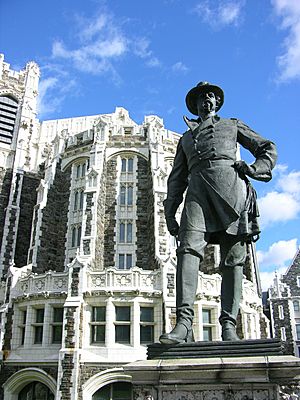
- John Jacob Astor III - a rich businessman and a general in the Union Army.
- Richard Delafield - a major general in charge of New York's defenses.
- Thomas Devin - a cavalry commander in the Union army.
- Hamilton Fish - a former Congressman, businessman, and commissioner.
- Benjamin F. Isherwood - a U.S. Navy officer who created new engineering ideas.
- Alexander S. MacKenzie - a U.S. Navy officer.
- Dennis Hart Mahan - a professor at West Point who was an expert in attacking forts.
- Wesley Merritt - a cavalry general in the Union Army.
- Timothy H. O'Sullivan - a famous early photographer.
- James B. Ricketts - a Union army general.
- Daniel Sickles - a corps commander in the Army of the Potomac.
- John Slidell - a Confederate political agent.
- Alexander S. Webb - a division commander in the Army of the Potomac.


